ASSIS AUPRÈS DE TOI, WATTEAU AND JULLIENNE IMMORTALIZED
© Martin Eidelberg
Created January 21, 2011
Click to Print or Download PDF Version
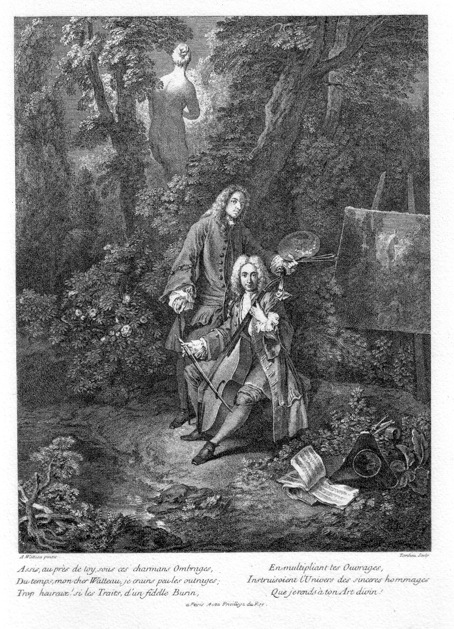 |
1. Nicolas Henri Tardieu after Antoine Watteau, Assis auprès de toi. |
One of the most endearing portraits conceived by Watteau is one that shows the artist together with his friend and patron Jean de Jullienne (fig. 1). Watteau is posed standing in the corner of a park, pausing from his work, while Jullienne sits nearby, bowing on a base viol. A statue of the Medici Venus, seen from behind, rises behind them. This record of the two men's alliance is like the picture of an artist and his inspiring muse. They were almost the same age, Watteau the senior by only two years. Both were lovers of the pictorial arts and music, and this double portrait establishes the notion of the harmony between these arts as well as the inspiration of Nature and the endurance of friendship.
Jullienne, the director of the Royal Gobelins Manufactory, was a good friend to Watteau and the artist benefited from his patron’s good will and hospitality. Watteau also was indebted to Jullienne for his financial acumen, especially when the South Sea bubble burst and Jullienne managed to save most of Watteau’s investment. After the painter’s death, his art continued to benefit from Jullienne’s patronage and support. Jullienne promoted Watteau’s paintings and drawings, not only by buying and selling them, but also by publishing a four-volume corpus of engravings after the artist’s works. As only a wealthy man could do, Jullienne assembled a large team of professional engravers and published four volumes, with more than 270 plates after the paintings and 350 plates after the drawings. Undoubtedly Jullienne hoped to profit from this vast undertaking, not only through the sale of the prints but also from the way that the engravings would increase the value of the examples of Watteau’s art that he already owned. Still, such financial considerations aside, one should recognize the singularity of Jullienne's project. The first such work monographic work, it was without parallel.2
Jullienne commissioned Nicolas Henri Tardieu to engrave the double portrait, and he pointedly positioned this memorial to their friendship to serve as the frontispiece of the first volume after the paintings. The legend engraved beneath is a six-line poem that cleverly pays tribute both to Watteau’s “divine” art and Jullienne’s role as publicist:
Seated near you, in this delightful shade,
My dear Watteau, I hardly fear the ravages of time,
I am only too happy if the marks of a faithful burin,
In multiplying your works,
Can instruct the world of the sincere homage
That I render to your divine art!3
Since the late nineteenth century, the opening words of this poem -- “Seated near you” (Assis auprès de toi) -- have been used to designate the composition.
Whereas the existence of the Tardieu engraving was normally welcomed, just as the loss of the original painting was bemoaned, the situation changed dramatically in 1922 when Émile Dacier and Albert Vuaflart proposed that this image was a hoax.4 They theorized that the composition was conceived by Julienne, and that Watteau had never painted such a double portrait. They argued that the engraving lacks the otherwise standard notation of the owner’s name, and that no picture like this was cited in eighteenth-century sales or inventories. To explain this they hypothesized that Assis auprès de toi was a composite of two or three other paintings.
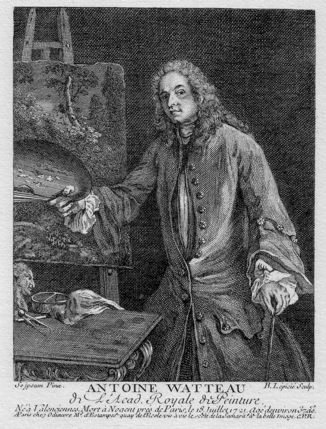 |
| 2. François Bernard Lépicié after Antoine Watteau, Self-portrait of Watteau. |
Dacier and Vuaflart claimed that the image of Watteau was taken from a Watteau self-portrait which Jullienne owned and which was described in the 1767 auction catalogue of his collection: “The portrait of Watteau painted by himself; he is half length, holding his palette and his maulstick, near a table; on panel, 5 pouces 6 lignes high, by 4 pouces 6 lignes wide.”5 This half-length portrait was engraved by Nicolas Bernard Lépicié, working for the publisher Odieuve (fig. 2).6 Dacier and Vuaflart thought it was significant that Jullienne did not engrave this half-length self-portrait for his corpus, as though he were hiding one of the sources of his pastiche.
3. Detail of the painting on the easel in Assis auprès de toi. |
Dacier and Vuaflart also claimed that the park setting and statue of Venus in Assis auprès de toi were derived from a landscape painting by Watteau which was described in the 1767 sale of Jullienne’s collection: “A landscape enriched with several buildings. One notices in the left foreground a group of figures 6 pouces high, consisting of two seated peasants, one of whom has a basket, a standing shepherd resting on his staff, three sheep and a ram.”7 Here again, Dacier and Vuaflart argued that by not including this landscape in L’Oeuvre gravé, Jullienne had attempted to hide another of the sources of his pastiche. They proposed that the Watteau landscape which Jullienne owned was reflected in the canvas seen on Watteau’s easel (fig. 3).
Finally, Dacier and Vuaflart conjectured that the image of Jullienne playing the viol in Assis auprès de toi might have been based on a portrait of Jullienne painted by a certain Villebois that was in the sitter’s collection. Nothing is known about Villebois nor is there any indication of the portrait’s appearance.
Dacier and Vuaflart’s theory has the outward appearance of being reasonable. Moreover, their cause was aided because of an underlying suspicion about Jullienne’s motives in creating L’Oeuvre gravé; scholars increasingly found occasions when they could question the veracity of Jullienne’s engravings. Thus Dacier and Vuaflart’s thesis found a ready audience. Louis Réau’s catalogue raisonné of Watteau’s works, published just a few years later, wholly followed Dacier and Vuaflart’s thesis and rejected Assis auprès de toi as a pastiche created by Jullienne. Gilbert Barker in his often neglected monograph on Watteau assumed essentially the same stance yet, even though he accepted the idea that the composition was a later pastiche, he dated it 1712 in relation to other paintings in Watteau’s oeuvre. Many scholars in the last half century have continued this point of view. Ettore Camesasca included the composition in his catalogue of Watteau’s paintings but in an ambiguous argument seemed to follow Dacier and Vuaflart’s reasoning.8 Marianne Roland Michel wrote that it was almost certain that Assis auprès de toi never existed.9 Donald Posner wrote that while he would like to believe that Watteau painted such a work, he was troubled by Dacier and Vuaflart’s arguments.10 More recently, Mary Vidal accepted the idea that the portraits engraved by Tardieu and Lépicié are likely “pastiches commissioned or personally designed by Jullienne;" the same position was taken by Helmut Börsch-Supan.11 Christian Michel has unhesitatingly rejected Assis auprès de toi as Jullienne’s fabrication.12
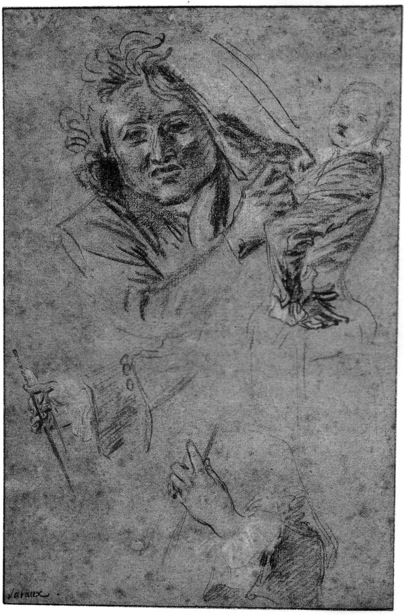 |
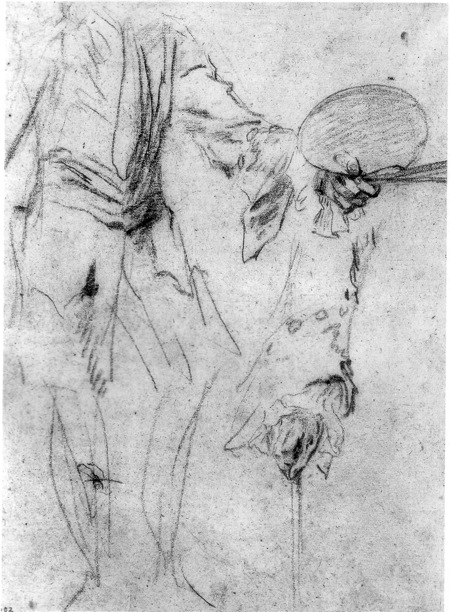 |
4. Antoine Watteau, Studies of actors and a man playing the base viol, sanguine with white chalk, 26.9 x 17.5 cm. France, private collection. |
5. Antoine Watteau, Studies of a standing painter, sanguine, 24.9 x 19 cm. Valenciennes, private collection. |
Nonetheless, there is good reason to believe that Watteau did paint the double portrait of himself and Jullienne. The evidence stems, in part, from two preparatory studies by Watteau, apparently made with the picture in mind, and those scholars who have considered the drawings have generally not reconciled their findings with Dacier and Vuaflart’s theory.
Almost at the same time that Dacier and Vuaflart were formulating their opinion, Raymond Bouyer discussed a Watteau drawing with several studies (fig. 4).13 It shows in the lower portion the barely indicated figure of someone playing a base viol, with the hands of the musician elaborated in careful detail.As he and others realized, this sanguine study with highlights in white chalk is for the figure of Jullienne in Assis auprès de toi. Dacier and Vuaflart themselves mentioned this drawing but, unfortunately, it did not make them rethink their argument. On the other hand, Karl T. Parker noted its relation to Assis auprès de toi but without alluding to the problematic nature of the double portrait.14 Victor Alvin-Beaumont, author of a vitriolic diatribe against Dacier and Vuaflart’s thesis, also illustrated the study of the two hands but his extraordinarily charged polemic was ultimately unconvincing and the drawing was not made sufficiently relevant.15 Worse still, Alvin-Beaumont tried to pass off a crude replica of Assis auprès de toi in his own collection as Watteau’s original painting, offering it as proof that the Tardieu engraving was not a falsification. Not surprisingly, critics did not heed Alvin-Beaumont’s arguments and the opportunity for serious reflection was lost.
Dacier and Vuaflart were unaware that there was another pertinent drawing by Watteau which seriously challenged their argument, one in sanguine chalk which features studies of an artist holding his palette and a staff (fig. 5). This drawing was evidently intended for the image of Watteau in Assis auprès de toi. It shows the artist full length and with his right leg bent at the knee, elements present in the full composition but not found in the half-length portrait engraved by Lépicié. When Jacques Mathey published this sheet in 1938, he simply proposed that it was used for both Assis auprès de toi and for the half-length portrait engraved by Lépicié.16 But he did not try to reconcile this drawing with Dacier and Vuaflart’s arguments, almost as though he was unaware of them.17 Yet this drawing is tremendously significant, especially when considered together with the studies for Jullienne’s hands.18
Scholars who have subsequently considered the two drawings have supported the belief that Watteau painted the double portrait of Jullienne and himself. Parker and Jacques Mathey catalogued both drawings with little surprise, even though they were aware of Dacier and Vuaflart’s theory.19 Jean Cailleux, while aware of Dacier and Vuaflart’s challenge, accepted the authenticity of the double portrait, seemingly because of the drawings.20 Likewise, Pierre Rosenberg and Louis-Antoine Prat duly noted the relationship of the two drawings to Assis auprès de toi, seemingly unmindful that it had been challenged by so many scholars.21 Obviously, the combined weight of the two Watteau drawings makes it evident that Watteau, not Jullienne, conceived the design of the double portrait.
A final key for resolving the issues surrounding Assis auprès de toi is found in the comments made in 1767 by Jean Pierre Mariette when the half-length self-portrait of Watteau was being sold from the Jullienne collection. In the margins of his copy of the auction catalogue he wrote: “It is in a deplorable state. These are the remains of a larger composition for which we have the engraving. One sees in it the painter accompanied by Monsieur de Jullienne playing the base viol.”22 Here, then, is an explanation of what actually happened. Contrary to Dacier and Vuaflart’s proposal, there really was a double portrait painted by Watteau, and this composition was recorded in the engraving of Assis auprès de toi. The double portrait then was cut down and a table was painted in the lower portion to create the half-length single portrait. Mariette’s use of the word “debris” is quite explicit. One wonders if Jullienne saved the image of himself as a separate piece. In any event, Dacier and Vuaflart’s suspicions can now finally be put to rest.
A word should be said about the landscape that Jullienne owned and which Dacier and Vuaflart proposed was the source for the painting on the easel in Assis auprès de toi. Many scholars have followed that engaging but ultimately specious theory.23 When
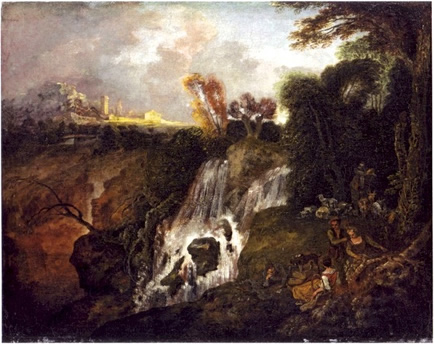 |
6. Antoine Watteau, La Chute d’eau, 51.1 x 63.2 cm.Paris, Mr. and Mrs. Lionel Sauvage collection. |
Louis Réau included the painting in his catalogue of Watteau’s work, rather than calling it just a landscape, he employed the title Park with a Statue to register what is seen in the painting on Watteau’s easel inthe double portrait. However, the description in the Jullienne sale catalogue makes it quite clear that his landscape showed a very different scene. As has already been noted, that work was a full-blown landscape with three rustic figures and farm animals in the foreground, and various buildings probably in the background. It was oriented vertically, not horizontally, and had no prominent statue. This picture has nothing to do with the scene galante on the easel in Assis auprès de toi. Indeed, the two compositions have nothing in common. The appearance of Jullienne’s landscape can be better imagined on the basis of another of Watteau’s landscapes, La Chute d’eau, a painting with several rustic characters as well as sheep and rams in the foreground, and distant buildings glistening in the sunlight (fig. 6). Clearly, then, Jullienne’s painting should not be titled Park with a Statue, even though that title has erroneously been continued by some Watteau scholars.24
The results of this study entail several readjustments in the Watteau corpus. While Assis auprès de toi can be reinstatedas a bona fide work by Watteau, the half-length portrait recorded by Lépicié no longer stands as an independent work; it is only the cut-down fragment of the double portrait. Although Jullienne’s landscape remains within the corpus of his established works, our sense of its appearance is changed. It is unlikely that either of these two paintings survived. Already cut down and in poor condition, Assis auprès de toi probably did not escape ravages of time. Similarly, no trace of the landscape has been found. Jullienne’s widow withdrew the landscape from the 1767 sale, but after its re-emergence in the 1778 sale of her collection, it entirely disappeared from view.25 There is little hope that it will miraculously resurface two and a half centuries later.26 Yet, even if neither work has survived, Tardieu’s engraving of the double portrait and the sale catalogue’s full description of the landscape offer us some idea, howsoever secondary, of what Watteau conceived and Jullienne treasured.
NOTES
1. Watteau is celebrated for his portrayals of musicians and singers, but his knowledge and appreciation of music may have been more profound. The Comte de Caylus reported: “Il avait de l’esprit, et quoiqu’il n’eut point reçu d’éducation, il avait de la finesse, et même de la délicatesse pour juger de la musique….” See Caylus, “La vie d’Antoine Watteau,” in Pierre Rosenberg, ed., Vies anciennes de Watteau (Paris: 1984), 68.
2. Pierre Crozat, the great financier and patron of the arts, had undertaken a similarly large project--publishing engravings after what he considered to be the most beautiful paintings in France, yet only the first of the intended two volumes was published.
3. “Assis, au près de toy, sous ces charmans Ombrages,/ Du temps, mon cher Watteau, je crains peu les outrages;/ Trop heureux! si les Traits, d’un fidelle Burin,/ En multipliant tes Ouvrages,/ Instruisoient l’Univers des sinceres hommages/ Que je rends à ton Art divin!”
4. Émile Dacier, Albert Vuaflart, and Jacques Hérold, Jean de Jullienne et les graveurs de Watteau au XVIIIe siècle, 4 vols. (Paris: 1922-29) 2: 107-10; 3: 6-7, cat. no. 3.
5. Sale, Paris, Jean de Jullienne collection, March 30-May 22, 1767, lot 256: “Le Portrait de Watteau peint par lui-même; il est à mi-corps tenant sa palette & son appui-main proche d’une table; sur bois, de 5 pouces 6 lignes de haut, sur 4 pouces six lignes de large.”
6. Dacier and Vuaflart, Jean de Jullienne et les graveurs…, 3: 127, cat. no. 127.
7. Sale, Paris, Jean de Jullienne collection, March 30-May 22, 1767, lot 254: “Un Paysage enrichi de plusieurs Fabriques: on remarque sur la premier plan à gauche un groupe de figures de 6 pouces de proportion, composé de deux Paysannes assises, dont une tient un panier, un Berger debout, appuyé sur son bâton, trois moutons & un bélier. Ce Tableau peint sur toile porte 3 pieds de haut, sur 2 pieds 4 pouces de large.” The manuscript inventory of Jullienne’s collection, compiled c. 1756 (now in the Morgan Library & Museum, New York, inv. 1966.8), 249, lists the painting under Watteau’s name: “Un Paisage de 29° sur 37° de haut” and designates it as being in the dining room.
8. Ettore Camesasca, L’opera completa di Watteau (Milan: 1968), cat. no. 209.
9. Marianne Roland Michel, Watteau, un artiste au XVIIIe siècle (Paris: 1984), 268-69.
10. Donald Posner, Antoine Watteau (Ithaca, NY: 1984) 251, note 44.
11. Mary Vidal, Watteau’s Painted Conversations. Art, Literature, and Talk in Seventeenth- and Eighteenth-Century France (New Haven and London: 1992), 158-67; Helmut Börsch-Supan, Watteau (Cologne:2000), 90.
12. Christian Michel, Le “Célèbre Watteau” (Geneva: 2008), 34.
13. Raymond Bouyer, “Watteau et la musique,” Revue de l’art ancien et moderne 40 (July/August 1921), 98.
14. Karl T. Parker, The Drawings of Antoine Watteau (London: 1931), 23.
15. Victor Alvin-Beaumont, Le Pedigrée, erreurs et vérités en art. Autour de Watteau (Paris: 1932), 20-27.
16. Jacques Mathey, “Aspects divers de Watteau dessinateur dans la collection Groult,” L’Amour de l’art 19 (December 1938), 376; see also idem, “Une Feuille d’études pour le ‘Gilles’ et le ‘Mezzetin à la guitarre’ de Watteau,” Münchner Jahrbuch der bildenden Kunst, ser. 3, vol. 7 (1956), 215.
17. Ironically, in Mathey’s 1938 study, 372, he praised Dacier and Vuaflart’s “monument d’erudition…à laquelle nous avons un recours constante.”
18. There would have been additional studies to establish the details of the painted figure. However, for the moment I am putting to the side the issues surrounding the portrait drawing of Watteau in the Musée Condé, Chantilly, even though the face and wig seen in that drawing are identical with Watteau’s image in Assis auprès de toi. The Chantilly drawing was engraved by François Boucher for the frontispiece to the first volume of Jullienne’s corpus of engravings after Watteau’s drawings, and while it was formerly attributed to Watteau, it is now generally ascribed to Boucher.
19. Karl T. Parker and Jacques Mathey, Antoine Watteau, catalogue complet de son oeuvre dessiné, 2 vols. (Paris: 1957-58) 2: cat. nos. 657, 820.
20. Jean Cailleux, “Un Portrait de Watteau par Rosalba Carriera,” Miscellanea I.Q. van Regteren Altena (Amsterdam: 1969), 176.
21. Pierre Rosenberg and Louis-Antoine Prat, Antoine Watteau 1684-1721, Catalogue raisonné des dessins, 3 vols. (Paris: 1996) 2: cat. nos. 588, 625.
22. “Il est dans un état déplorable. Ce sont les debris d’une plus grande composition dont on a l’estampe on y voyoit le peintre accompagné de M.r de Jullienne jouant de la basse de Viole.” These are Mariette’s annotations in his copy of the Jullienne sale catalogue, now in the National Art Library, London.
23. Adhémar, Antoine Watteau, sa vie¾son oeuvre, cat. no. 69; Camescasa and Montagni, L’opera completa di Watteau, no. 78; Roland Michel, Watteau, un artiste au XVIIIe siècle, 204.
24. See, for example, Adhémar, Antoine Watteau, sa vie¾son oeuvre, cat. no. 69, as “Paysage enrichi de plusieurs fabriques, dit Le Parc à la staue.” InCamescasa and Montagni, L’opera completa di Watteau, no. 78, the title appeared as “Paesaggio con due contadine e un pastore,” but in the French edition by Rosenberg and Camesasca, Tout l’oeuvre peint de Watteau (Paris: 1968), no. 78, it reverted to “Paysage enrichi de plusieurs fabriques, dit Le Parc à la statue.”
25. Mariette noted in his copy of the 1767 Julienne sale catalogue (London, National Art Library): “Il n’a pas eté exposé.” The copy of the Jullienne sale catalogue in the Bibliothèque nationale, Paris, bears the annotation “reservé par Mme Julienne.”
26. Sale, Paris, Madame de Jullienne collection, November 5 ff, 1787, lot 39: “Un grand paysage.”
